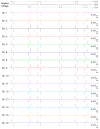Parallel Recordings of Transmembrane hERG Channel Currents Based on Solvent-Free Lipid Bilayer Microarray
- PMID: 33478052
- PMCID: PMC7835820
- DOI: 10.3390/mi12010098
Parallel Recordings of Transmembrane hERG Channel Currents Based on Solvent-Free Lipid Bilayer Microarray
Abstract
The reconstitution of ion-channel proteins in artificially formed bilayer lipid membranes (BLMs) forms a well-defined system for the functional analysis of ion channels and screening of the effects of drugs that act on these proteins. To improve the efficiency of the BLM reconstitution system, we report on a microarray of stable solvent-free BLMs formed in microfabricated silicon (Si) chips, where micro-apertures with well-defined nano- and micro-tapered edges were fabricated. Sixteen micro-wells were manufactured in a chamber made of Teflon®, and the Si chips were individually embedded in the respective wells as a recording site. Typically, 11 to 16 BLMs were simultaneously formed with an average BLM number of 13.1, which corresponded to a formation probability of 82%. Parallel recordings of ion-channel activities from multiple BLMs were successfully demonstrated using the human ether-a-go-go-related gene (hERG) potassium channel, of which the relation to arrhythmic side effects following drug treatment is well recognized.
Keywords: bilayer lipid membrane (BLM); human ether-a-go-go-related gene (hERG) channel; ion channel; microarray.
Conflict of interest statement
The authors declare no conflict of interest.
Figures







Similar articles
-
Mechanically stable solvent-free lipid bilayers in nano- and micro-tapered apertures for reconstitution of cell-free synthesized hERG channels.Sci Rep. 2017 Dec 18;7(1):17736. doi: 10.1038/s41598-017-17905-x. Sci Rep. 2017. PMID: 29255199 Free PMC article.
-
Reconstitution of human ether-a-go-go-related gene channels in microfabricated silicon chips.Anal Chem. 2013 May 7;85(9):4363-9. doi: 10.1021/ac303484k. Epub 2013 Apr 9. Anal Chem. 2013. PMID: 23514363
-
Reconstitution of Human Ion Channels into Solvent-free Lipid Bilayers Enhanced by Centrifugal Forces.Biophys J. 2016 May 24;110(10):2207-15. doi: 10.1016/j.bpj.2016.04.010. Biophys J. 2016. PMID: 27224486 Free PMC article.
-
Stable lipid bilayers based on micro- and nano-fabrication as a platform for recording ion-channel activities.Anal Sci. 2012;28(11):1049-57. doi: 10.2116/analsci.28.1049. Anal Sci. 2012. PMID: 23149604 Review.
-
Micro- and nano-technologies for lipid bilayer-based ion-channel functional assays.Chem Asian J. 2015 Jun;10(6):1266-74. doi: 10.1002/asia.201403391. Epub 2015 Feb 20. Chem Asian J. 2015. PMID: 25702941 Review.
Cited by
-
Assembly of Cell-Free Synthesized Ion Channel Molecules in Artificial Lipid Bilayer Observed by Atomic Force Microscopy.Membranes (Basel). 2023 Oct 25;13(11):854. doi: 10.3390/membranes13110854. Membranes (Basel). 2023. PMID: 37999340 Free PMC article.
-
New Aspects of Bilayer Lipid Membranes for the Analysis of Ion Channel Functions.Membranes (Basel). 2022 Sep 6;12(9):863. doi: 10.3390/membranes12090863. Membranes (Basel). 2022. PMID: 36135882 Free PMC article. Review.
References
-
- Miller C. Ion Channel Reconstitution. Plenum Publishing; New York, NY, USA: 1986.
-
- Tiefenauer L., Demarche S. Challenges in the development of functional assays of membrane proteins. Materials. 2012;5:2205–2242. doi: 10.3390/ma5112205. - DOI
-
- Kongsuphol P., Fang K.B., Ding Z. Lipid bilayer technologies in ion channel recordings and their potential in drug screening assay. Sens. Actuators B. 2013;185:530–542. doi: 10.1016/j.snb.2013.04.119. - DOI
-
- Imbrici P., Liantonio A., Camerino G.M., De Bellis M., Camerino C., Mele A., Giustino A., Pierno S., De Luca A., Tricarico D., et al. Therapeutic approaches to genetic ion channelopathies and perspectives in drug discovery. Front. Pharmacol. 2016;7:121. doi: 10.3389/fphar.2016.00121. - DOI - PMC - PubMed
Grants and funding
- JPMJCR14F3/Japan Science and Technology Agency
- 15H03822/Japan Society for the Promotion of Science
- 19H00846/Japan Society for the Promotion of Science
- 20K15148/Japan Society for the Promotion of Science
- N/A/Nation-wide Cooperative Research Projects, Research Institute of Electrical Communication, Tohoku University
LinkOut - more resources
Full Text Sources
Other Literature Sources

